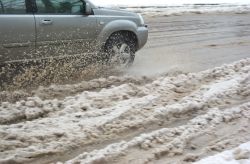3 Ways Cold Weather Affects Your Brakes

Cold temperatures come with hail, snow, and strong winds, and these weather conditions create hazardous driving conditions. Before winter begins, visit an auto repair shop to have the car brakes inspected and adjusted to prevent issues. Here’s how the season will affect the system.
How Brakes Are Impacted by Cold Temperatures
1. Increase Wear
Snowy and icy roads are challenging to navigate, so drivers will use their brakes frequently to keep from sliding across the road. Since the brakes are used more than usual, the rotors and pads will experience excess wear—this results in a shortened life span. Listen for whirring, grinding, and squealing, as they indicate early brake failure.
2. Corrode the Undercarriage
 Road salt is applied to help clear ice buildup, providing better traction and safer driving conditions. However, this substance can be harmful to your brakes since it can get caught in the vehicle’s undercarriage and tires.
Road salt is applied to help clear ice buildup, providing better traction and safer driving conditions. However, this substance can be harmful to your brakes since it can get caught in the vehicle’s undercarriage and tires.
If ignored, the road salt will corrode the car’s metal components, including the brakes. To avoid this issue, wash your vehicle often during the colder months and pay extra attention to the undercarriage.
3. Overheat
Braking generates heat when the pads press against the rotors. Since cold, moist air acts as a lubricant, you’ll need to apply more pressure to brake effectively. The added force will create more heat, and the pads may dry and crack. Always maintain a proper following distance, so you don’t need to slam on the brakes and increase the gap if the roads are icy.
If you want to have your brakes checked before winter arrives, turn to Alaskan Auto Center in Anchorage. This locally owned business has provided drivers with reliable auto repairs for nearly 17 years. They’re familiar with domestic and imported vehicles and will provide a 12-month warranty on qualified services. Get more information about their auto repairs online, or call (907) 522-7035 to request a free auto repair estimate.
About the Business
Have a question? Ask the experts!
Send your question

